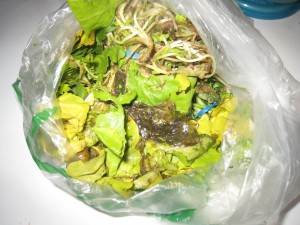What Are You Wasting?
- by KitchenPantryScientist
According to the new book “American Wasteland: How America Throws Away Nearly Half of Its Food”,by Jonathan Bloom, Americans are throwing away up to half of the food produced in this country. We should be ashamed of ourselves.
The waste begins in the fields, where produce that is imperfect, or hard to pack, is left to rot. From there, our food takes a 1,500 mile (on average) journey to the grocery store. There are casualties of up to 15% along the way. Once in the supermarket, an enormous amount of imperfect produce and meat is discarded.
The few, hardy survivors that reach our refrigerators at home stand a 15% to 25% of being tossed into the trash, rather than eaten.
I’d love to say that I wasn’t guilty of throwing food away, but I can’t. I waste an embarrassing amount of food. Piles of lunch meat get tossed every week when I think three days have passed. (Didn’t I see something on the news once about how quickly lunch meat goes bad?) Sometimes I have to hold my nose as I carry an unrecognizable vegetable to the organic composting bin. Meat gets pushed to the back of the freezer, soon to be covered with a layer of white permafrost.
Wasting food is not only expensive, but it’s bad for the environment. Food rotting in landfills adds methane gas (a greenhouse gas) to our already warming atmosphere.
What can I do? I can cut a bad spot off of a red pepper and use it anyway. I can make banana bread and apple crisp out of brown bananas and mushy apples. I can label food in my freezer and try to use it before it becomes mystery meat. I can try to buy more food that’s grown and raised locally, so it doesn’t have the chance to rot in trucks.
I’m on a mission!
How much food do you waste? What do you do to keep track of and use the food you have on hand? I’d love to hear your tips!
You can go to stilltasty.com to find out what the shelf life is on the food in your fridge. You may be able to keep some foods longer than you think! Just remember to always throw away moldly nuts and breads, since they can contain potent toxins made by fungi.
